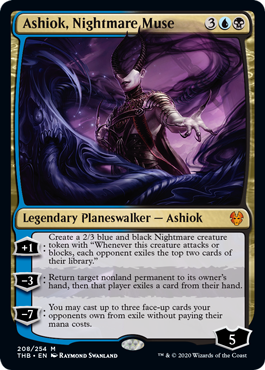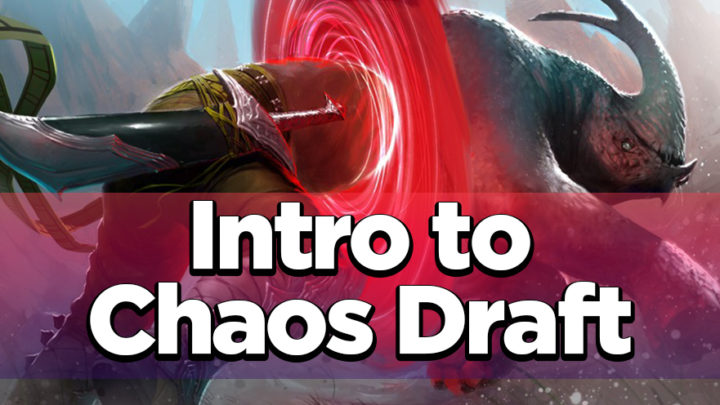Quick poll for you, readers! How many of you out there are still regularly drafting Theros Beyond Death? And, if you are still drafting it, are you enjoying it as much as you did in the first week or two?
It’s very common that the shine starts to come off of booster draft formats over time, no matter how well-received they are initially. Players get over the novelty of the set mechanics and archetypes; pushed cards like Dream Trawler or Kiora Bests the Sea God start to become frustrating; strategy websites publish articles that help you see ahead to the endgame of the set.
If you’d rather chase the sense of wonder and improvisation you feel during the first draft of a new set, Chaos Draft is worth trying. Like Cube (which we explored last week), Chaos Draft allows players to sample the vast card pool and design space Magic has to offer. However, Chaos Draft has a far lower barrier to entry, so it can be a great opportunity to see how you enjoy this style of play. The format can even help you discover some of the card interactions you may wish to include in a Cube.
INTRODUCING CHAOS
If you haven’t played Chaos Draft before, the concept is simple. Chaos Draft is like a normal booster draft, but each player brings their own choice of three booster packs from across Magic history. Usually, players coordinate to include as many unique sets as possible — you can draft as many as 24 unique sets!
Sometimes, players “draft” the packs themselves to fairly decide who gets to open which set. But many drafts allow you to open the three you bring. Either way, you’re guaranteed to encounter new card interactions, deck configurations, and unpredictable game states with every draft. It’s like having that fresh new format experience every time!
One misconception which seems to hold back the popularity of Chaos Draft is the sheer scope of the format. How can you properly prepare yourself for a Chaos Draft against experienced opponents? Do you need to know every card from every set?
Of course, it helps, but perhaps less than you might think; the range of possible cards is wide enough that preparation can only go so far. Instead, it helps most to have a strong general idea of how to evaluate cards for this format. Luckily, you can pick that up in just a few minutes!
CARD EVALUATION
Alright, onto the real tech: What is good in Chaos Draft? Broadly, things that are already good in draft are good here, too — especially bombs and removal. For those who don’t draft much, “Bomb” usually means “rare creature”– but not always. Ethan Saks from the Lords of Limited podcast has a handy definition: “For me, a bomb is a card that can change the state of the game for a single player (move them from being behind to being at parity, or from parity to being ahead) and will win the game on its own if unanswered.”
Beyond drafting bombs which win you the game and cards which kill opposing bombs, it’s important to remember how the mixed set environment of Chaos Draft changes card valuations. Modern Limited formats are largely built around specific synergies, with signpost uncommons highlighting the themes in each color which you can mix together to make a cohesive deck. But Chaos Draft yanks that context away and often the balance comes with it.
In a draft where every pick comes from a different set, there’s no way to reliably take advantage of synergies; cards which lean on these ideas are significantly worse here. Similarly, formats defined by parasitic mechanics (such as energy cards in Kaladesh block) or by unusual set design (such as the artifact-based Mirrodin blocks) are usually quite weak in Chaos Draft.
The best cards in Chaos Draft generate card or mana advantage, or are just generally strong. Creatures with evasion (or banding!), recurring spells, and flexible cards like Charms and kicker spells are all great examples.
Some cards whose mechanical synergies are broad enough can also work outside of their intended environment. Ferocious (4+ power matters), +1/+1 counter synergies, and graveyard mechanics are all common enough for you to cobble together a critical mass of them, no matter which sets appear in a given draft!
EXPECT THE UNEXPECTED
When your goal is to draft cards which are individually powerful above all, it is vital to remain as flexible in your colors as possible until you find an open lane. Many Chaos Draft pools have low overall card quality due to the presence of weak commons in older sets, not to mention the number of normally-playable cards which are significantly weaker outside of their original set. This means you can ill-afford to be the third player in your color, picking up scraps. Drafting mana fixing and ramp highly allows you to take as many priority picks as possible, no matter what colors they are. Then, you can settle into a combination once you get a clear signal it’s open.
This means that “reading signals” is even more crucial than usual, and that you should prioritize fixing and ramp very highly. Also, while you might think that gold cards would be a lower priority by this metric, a strong gold bomb is just as often your signal to jump into those colors for the rest of the draft. Mana requirements reduce competition, so seeing a gold card mid-pack means future cards in that color combination are likely to come around!

On the other hand, a common trap for new players is overcommitting to an all-out aggro strategy. A successful aggro deck is much harder to pull off in Limited because your chance of stumbling is so high. Plus, Chaos Draft decks are already prone to that kind of inconsistency. Unless you have confidence and experience (and good early picks), it’s safer to go for a slower, value-based plan and ensure you get to play your best cards.
While finding enough playables in your colors is non-trivial in Chaos Draft, it’s still worth considering your sideboard. You should always pay attention to how the first game of each match unfolds, and be ready to adjust your strategy for the remaining games. Chaos Draft has a lot of potential for one-card blowouts, and you’ll need to sideboard when that’s the case.
Traditional sideboard effects like Disenchant or Nihil Spellbomb can be good as well. But more than anything else, their value depends on what you scout from the packs going around the table. Did you see Pharika’s Spawn out of that Theros Beyond Death booster someone brought? You might suddenly decide it’s worth prioritizing that Withered Wretch in front of you!
WEAPONS OF CHOICE
Players signing up for a Chaos Draft also have a unique metagame consideration to ponder: Which three boosters will you add to the card pool? For many players, getting to draft fun and unusual sets is part of the hook for this format; don’t be afraid to dial in some of your favorite Limited packs or an ancient booster you found in a garage sale. However, keep in mind that you’re playing Draft, not Sealed. Even if you bring Mirrodin Besieged/Darksteel/Aether Revolt, you could struggle to draft your dream artifact deck.
If you can’t find or afford some of the older and more exotic boosters, Mystery Booster is a terrific option. It was designed to create a Chaos-like draft experience in the first place, and all the weird and powerful “playtest card” designs can transform your card pool with their unique synergies.

Of course, you might prefer to try and think of an optimal pack setup for the best chance at winning. In that case, the Spike play is to use sets with many above-rate common and uncommon picks, typically good removal. While the odds of sniping a hall-of-fame rare like Umezawa’s Jitte are miserable out of your single Betrayers of Kamigawa pack, your odds of pulling a mega-common like Capsize or Sprout Swarm is significant enough to be worth a try.
It’s also a decent idea to choose a booster from a multicolor-heavy set as your first pack in the draft. Ravnica: City of Guilds, Khans of Tarkir, Alara Reborn or Apocalypse may yield a gold bomb rare or premier uncommon, which will help you pick an early direction. These sets also have the best color fixing to support the demands of their original environments.
IN THE EYE OF CHAOS
However seriously you approach Chaos Draft, it’s always exciting to discover a line you’ve never seen before. That sense of discovery is part of Commander’s appeal, and Chaos Draft can provide a taste of the same fun. Look out for your chance to give it a go!

Tom’s fate was sealed in 7th grade when his friend lent him a pile of commons to play Magic. He quickly picked up Boros and Orzhov decks in Ravnica block and has remained a staunch white magician ever since. A fan of all Constructed formats, he enjoys studying the history of the tournament meta. He specializes in midrange decks, especially Death & Taxes and Martyr Proc. One day, he swears he will win an MCQ with Evershrike. Ask him how at @AWanderingBard, or watch him stream Magic at twitch.tv/TheWanderingBard.

